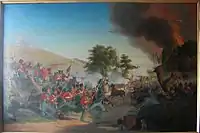Battle of Dybbøl (1848)
The First Battle of Dybbøl was the first of three battles of the First War of Schleswig to be fought at Dybbøl between the Danish army and forces of Prussia and other German states.[1][2][3][4][5][6]
| Battle of Dybbøl (1848) | |||||||
|---|---|---|---|---|---|---|---|
| Part of First Schleswig War | |||||||
 | |||||||
| |||||||
| Belligerents | |||||||
|
|
| ||||||
| Commanders and leaders | |||||||
|
|
| ||||||
| Strength | |||||||
|
20,000 11,500 reserves | 14,000 | ||||||
| Casualties and losses | |||||||
| 337 killed & wounded | 230 killed & wounded | ||||||
Background
To remove the threat to his right flank after the battle at Nybøl, General Wrangel decided to try a new attack on the Danish forces at Sundeved. Three German brigades (with a total of 11,500 men) are gathered at the village of Kvaers and prepared for an immediate departure. The Danes scaffolding stretched from Nybølviken, the south of Korsmose mill and Snokebaek to Alssundet in the north. The lines of defense were kept by the Danish flank division and parts of the 4th Brigade while the 3rd Division was kept in reserve at Dybbøl. The rest of the Danish army order to hold on to Als.
Battle
At noon, the German right wing corp under Colonel Marshalk, reached the Nybøl mill where fighting broke out with Danish infantry units. After a minor battle, the Danish troops were forced to withdraw. By one o'clock, General Bonin's forces had reached the village of Sotrup, where the troops made a halt to rest after a long march. At the same time, the Danish brigades was reinforced with fresh reinforcement from Als. At 14.00 hour, the entire Danish army had converged at Dybbøl. Bonin stay in Sotrup and also forced the other German forces to wait. When all the German forces were finally in place, Marschalk's brigade went on the offensive against the Danish positions. The German artillery was located on open ground and therefore became an easy target for Danish cannonballs in Vemmingbund. After a short artillery duel, the artillerymen were forced to pull back. Without artillery support, the German troops was repulsed by the Danes well trained infantrymen. General Wrangel, realizing the futility of continuing the fight, interrupted the attack. When the Danish general Friderich Adolph Schleppegrell heard about the German forces are on the run, he launched a counterattack regained their territories that was lost the day before.
Consequences
Shortly after the battle, a ceasefire was concluded in Malmö after Swedish mediation. The advance of the Danish army was interrupted, which gave the Germans gave the opportunity to retreat in good order.
